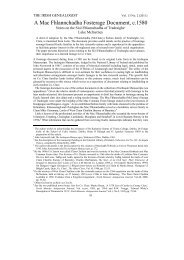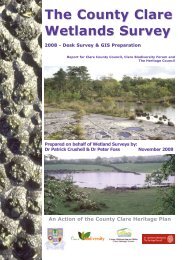Documents from the Thomond Papers at Petworth House Archive1 ...
Documents from the Thomond Papers at Petworth House Archive1 ...
Documents from the Thomond Papers at Petworth House Archive1 ...
You also want an ePaper? Increase the reach of your titles
YUMPU automatically turns print PDFs into web optimized ePapers that Google loves.
Archivium Hibernicum<br />
Historians would be well served by gre<strong>at</strong>er recourse to this repository<br />
of m<strong>at</strong>erial. It is hoped th<strong>at</strong> <strong>the</strong> documents reproduced here encourage a<br />
more detailed survey and public<strong>at</strong>ion of <strong>Petworth</strong> m<strong>at</strong>erial pertaining to<br />
<strong>the</strong> <strong>Thomond</strong> est<strong>at</strong>es. Examples for future work th<strong>at</strong> could be commended<br />
to <strong>the</strong> historian include a transl<strong>at</strong>ion of <strong>the</strong> 1624 L<strong>at</strong>in inquisition post<br />
mortem of Donough O’Brien, fourth earl of <strong>Thomond</strong>, and a transcription<br />
of <strong>the</strong> 1619 inquisition into <strong>the</strong> earl’s lands. Public<strong>at</strong>ion of fur<strong>the</strong>r documents<br />
contained in <strong>the</strong> archive would be of gre<strong>at</strong> benefit, not least because<br />
<strong>the</strong> historiography of Co. Clare would be much advanced by more frequent<br />
reference to this extraordinary archive.<br />
contrast to <strong>the</strong> will of Murrough O’Brien in 1551 which does not mention any individuals<br />
<strong>from</strong> outside of <strong>Thomond</strong>. See Brian Ó Dálaigh, ‘From Gaelic Warlords to English Country<br />
Gentlemen: The O’Briens of <strong>Thomond</strong> 1543–1741’ and Brian Ó Dálaigh, ‘A compar<strong>at</strong>ive study<br />
of <strong>the</strong> wills of <strong>the</strong> first and fourth Earls of <strong>Thomond</strong>’ in North Munster Antiquarian Journal,<br />
xxxiv (1992), pp 48–63. For articles th<strong>at</strong> touch on <strong>the</strong> life and actions of Donough O’Brien,<br />
fourth Earl of <strong>Thomond</strong>, see Andrew O’Regan, <strong>Thomond</strong> and <strong>the</strong> Tudor Crown: Enforced<br />
Change in a Gaelic Lordship (Unpublished PhD <strong>the</strong>sis, UCD, 1987); and Brendan Kane,<br />
The Politics and Culture of Honour in Britain and Ireland, 1541–1641, Cambridge University<br />
Press (Cambridge, 2009) pp 158–180. The l<strong>at</strong>ter contains references to <strong>the</strong> earl’s interest in<br />
asserting legitimacy through genealogies and divining points <strong>from</strong> antiquarian works in<br />
advancing his political aspir<strong>at</strong>ions. Also note <strong>the</strong> evidence presented by <strong>the</strong> earl in 1601 as to<br />
why <strong>Thomond</strong> should not be annexed to Connacht. Various points can be evinced, including<br />
<strong>the</strong> similarity of Irish spoken in <strong>Thomond</strong> and Munster, and <strong>the</strong> etymological origin of <strong>the</strong><br />
place-name <strong>Thomond</strong>: ‘Twoghwene’ viz north Munster, purported, and so continued <strong>the</strong>se<br />
1,300 years’. One wonders whe<strong>the</strong>r <strong>the</strong> evidence submitted owes its precision to a member<br />
of <strong>the</strong> Mac Bruaideadha family, possibly Tadhg mac Dáire Mac Bruaideadha, employed by<br />
<strong>the</strong> earl. See J.S. Brewer & William Bullen Esq. (eds), Calendar of <strong>the</strong> Carew Manuscripts<br />
Preserved in <strong>the</strong> Archiepiscopal Library <strong>at</strong> Lambeth, 1601–1603, pp 171–176.<br />
34

















